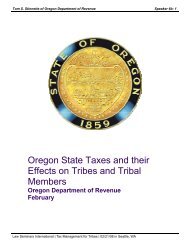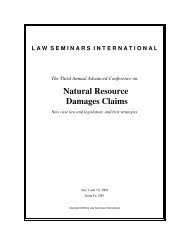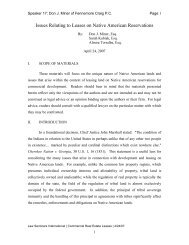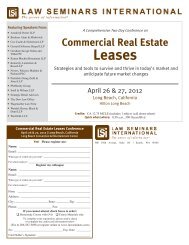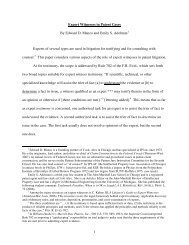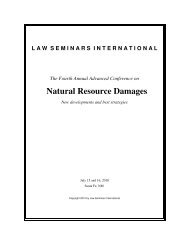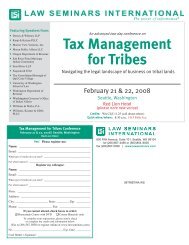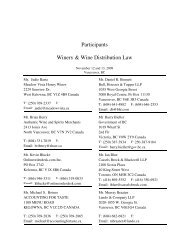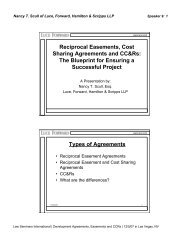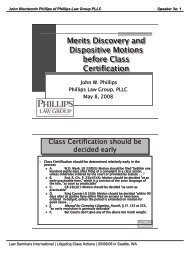LSI 2010 Real Estate Joint Ventures conference materials.pdf
LSI 2010 Real Estate Joint Ventures conference materials.pdf
LSI 2010 Real Estate Joint Ventures conference materials.pdf
Create successful ePaper yourself
Turn your PDF publications into a flip-book with our unique Google optimized e-Paper software.
John W. Hanley, Jr. of Davis Wright Tremaine LLP Speaker 20a: 6<br />
Foreclosures, deeds-in-lieu and distressed sales are of course the painful exceptions. The<br />
prospective investor will want to know whether the fund sponsor will have discretion to reinvest<br />
recovered investment capital, instead of distributing capital proceeds back to the investors, and,<br />
if so, under what circumstances. Such discretion is uncommon but possible. By contrast, it is<br />
quite customary for the fund manager to have broad authority to establish a certain levels of cash<br />
reserves, for certain purposes, at the fund level. Prospective investors should focus on the<br />
purposes, circumstances and amounts of such reserves, since reserves will reduce “net” cash<br />
flow and “net” capital proceeds available for distributions to fund investors.<br />
Distributions – The Waterfall and Other Issues. The stated formula for distribution of net<br />
proceeds realized from operations, or from a capital event, will be of real interest to the<br />
prospective investor. Such formulas are typically referred to as “the waterfall,” and they are not<br />
unlike those found in real estate joint venture agreements, although the economic results may be<br />
considerably different (depending on a host of considerations). Most commonly (and<br />
generalizing somewhat), the distribution formula will promise three levels of distributions:<br />
(a) first, distributions to the investors until they have realized a stated “preferred<br />
return” on the investors’ capital (either limited to the investors’ capital in the capital asset giving<br />
rise to the distributable proceeds, or on total invested capital);<br />
(b) distributions to the investors until they have received a return of their invested<br />
capital (again, measured either with respect to the capital in the subject capital asset, or a<br />
cumulative basis); and<br />
(c) distributions to the investor and the fund manager effecting a final division of<br />
remaining distributable proceeds between the investors (as a group) and the fund manager, in<br />
proportions having little to do with the amount of invested capital, in order to give to the fund<br />
manager a “carried interest” in the profits of the enterprise as a reward for his services.<br />
Typically, the fund manager will also commit to invest a certain amount of his own<br />
capital in the fund (usually in the range of 1%-5% of total commitments to the fund), because<br />
prospective investors usually expect (or require) the fund manager to have some of his own skin<br />
in the game. For purposes of the waterfall, the fund manager as capital investor may be treated<br />
in a manner indistinguishable from all other investors (i.e., as part of the “investor group”), or the<br />
distributions with respect to his capital investment may, at each of the first two tiers, be expressly<br />
subordinated to the distributions at that tier to all other fund investors.<br />
There are important details to be addressed at all tiers in the waterfall, but, frequently, the<br />
carried interest tier commands greatest attention and is the source of greatest controversy. The<br />
amount of the carried, or “promoted,” interest received by the manager is of course a key<br />
consideration. During the boom years, the classic formulation in the world of hedge funds and<br />
private corporate equity funds was the “80/20 after an 8”, meaning that the preferred return at<br />
tier two of the waterfall was set at 8% per annum and the third tier featured a 20% promoted<br />
interest for the fund manager. As market conditions became more heated, there were reports of<br />
funds offering smaller preferred returns and requiring a larger percentage promote (perhaps 25%-<br />
30%) for the fund sponsor.<br />
DWT 13620946v1 0000099-071219<br />
Law Seminars International | <strong>Real</strong> <strong>Estate</strong> <strong>Joint</strong> <strong>Ventures</strong> and Funds | 02/09/10 in Seattle, WA<br />
5




